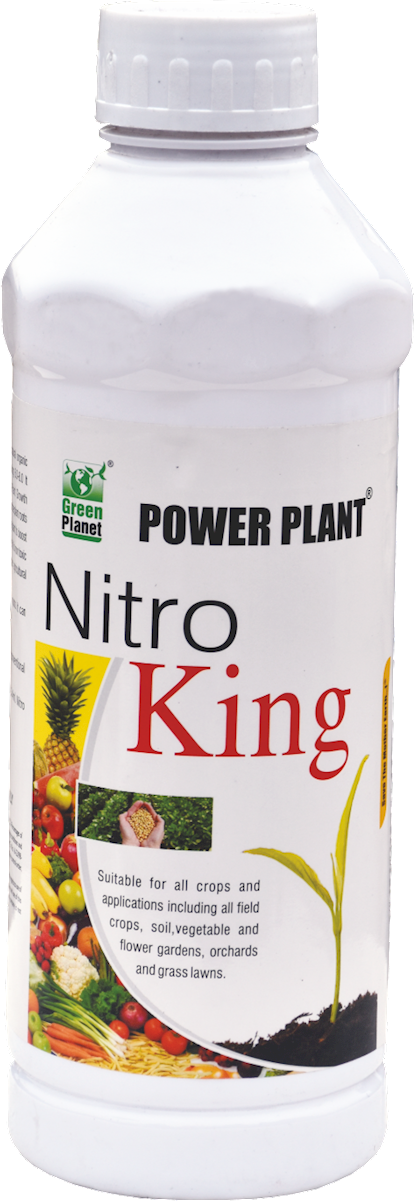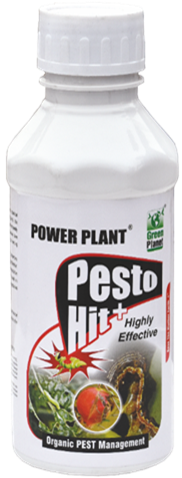
FOR IRRIGATION :
Irrigate your field with Power Plant Bhoomi power, Premium, and Root guard.
|
BHOOMI POWER 4KG/ACRE |
 |
|
POWER PLANT PREMIUM 1 LITRE/ ACRE |
 |
|
ROOT GUARD 2 KG/ACRE |
 |
HOW TO USE IT?
Use Bhoomi power by following methods.
1. By broadcasting over the field.
2. Use in slurry.
3. Give it in cow dung.
4. you can also give it in dry soil.
Note: Repeat Bhoomi power and Root guard every 3 months.
1. DEFICIENCY OF NITROGEN
- Nitrogen deficiency first appears on older leaves and then proceeds toward younger leaves.
- It is characterized by light yellowish-green leaves. The veins are only slightly lighter in color than the tissue in between.
- New leaves are small, thin, fragile, and light green.
- The fruit peel tends to be smooth and pale in color, and the juice has lower soluble solids and acid concentrations.
TREATMENT :
|
Use NITROKING 2-3 ml per litre of water |
 |
|
Use SPALL90 0.5 ml per litre of water |
 |
2. DEFICIENCY OF MAGNESIUM
- Symptoms develop on mature leaves during any season, but most usually as the fruit is maturing, especially in limbs bearing a heavy crop.
- Yellow blotches start near the center of the leaves and eventually coalesce.
- New leaves are at first a normal green, but in severe cases can go yellow before they are one year old.
TREATMENT :
|
Use NITROKING 2-3 ml per litre of water |
 |
|
Use SPALL90 0.5 ml per litre of water |
 ??????? ??????? |
3. DEFICIENCY OF ZINC
- Leaves of zinc-deficient citrus are small, abnormally narrow, and rather crowded on short stems, giving a bunched appearance.
- The areas between the main lateral veins are whitish-yellow.
- This mottling, which first appears between the main veins, occurs in the young growth and persists as the leaf ages.
- Fruit tends to be small, rather elongated, pale and coarse.
- There is considerable dieback of the smaller twigs, with the production of multiple buds and numerous small, weak shoots, so that the trees become bushy and stunted.
TREATMENT :
|
Use Zinc EDTA 0.5 gm per litre of water |
 |
|
Use Grow 2 ml per litre of water |
 |
|
Use SPALL90 0.5 ml per litre of water |
 |
4. DEFICIENCY OF POTASSIUM
- Potassium deficiency causes slow vegetative growth, small leaves, fine branches, thin canopy, and increased susceptibility to drought and cold.
- Reduced fruit size, very thin peel of smooth texture, premature shedding of fruit, and lower acid concentration in the fruit.
- Necrotic areas and spots can develop on the leaves.
TREATMENT :
|
Use NITROKING 2-3 ml per litre of water |
 |
|
Use SPALL90 0.5 ml per litre of water |
 |
???????5. DEFICIENCY OF BORON
- The first signs appear on the younger leaves as water-soaked spots which become translucent. The veins tend to be thick, cracked, and corky.
- The young leaves wilt and curl, and have a dull brownish-green color without any luster. Dieback of leaf tips is common.
- A gummy exudate may appear on the twigs and fruit pedicels.
- They characteristically show internal gum formation.
- Normally, the gummed spots cannot be seen unless the fruit is cut.
- Excessive fall of young fruit occurs, resulting in very poor yields. This may be the first sign of a boron-deficiency problem.
TREATMENT :
|
Use NITROKING 2-3 ml per litre of water |
 |
|
Use BLOOM 2 ml per litre of water |
 |
|
Use SPALL90 0.5 ml per litre of water |
 |
???????6. DEFICIENCY OF MANGANESE
- Manganese deficiency may greatly reduce crop volume and fruit color.
- The fruit may become smaller and softer than normal, and the rind may become pale in color.
- The color of the leaf becomes dull green or yellowish-green along the midrib and main lateral veins, and it becomes pale and dull in the interveinal areas.
- White opaque spots may develop in the interveins, which give the leaf a whitish or gray appearance.
- The leaves are not reduced in size or changed in shape by Mn deficiency, but affected leaves prematurely fall from the tree.
TREATMENT :
|
Use Manganese EDTA 0.5 gm per litre of water |
.png) |
|
Use Grow 2 ml per litre of water |
 |
|
Use SPALL90 0.5 ml per litre of water |
 |
???????7. DEFICIENCY OF CALCIUM
- A deficiency of calcium in citrus is expressed as a fading of the chlorophyll along the leaf margins and between the main veins during the winter months.
- Small necrotic (dead) spots can develop in the faded areas.
- Calcium deficiency produces small, thickened leaves and causes loss of vigor, thinning of foliage and decreased fruit production.
- Severely deficient trees can develop twig dieback and multiple bud growth of new leaves. Trees grown under Ca deficiency produce undersized and misshapen fruit with shriveled juice vesicles.
- Fruit from Ca-deficient trees are slightly lower in juice content but higher in soluble solids and acids.
TREATMENT :
|
Use Calcium EDTA 0.5 gm per litre of water |
 |
|
Use Grow 2 ml per litre of water |
 |
|
Use SPALL90 0.5 ml per litre of water |
 |
1. FUNGAL DISEASE: CONTACT-BASED FUNGAL DISEASE
1. ANTHRACANOSE ( Discula destructive)
TREATMENT :
|
Use PPFC 2-3 gm per litre of water |
 |
|
Use SpAll90 0.5 ml per litre of water |
 |
2. SWEET ORANGE SCAB (ELSINOE AUSTRALIS)
TREATMENT :
|
Use PPFC 2-3 gm per litre of water |
 |
|
Use SpAll90 0.5 ml per litre of water |
 |
3. POWDERY MILDEW (OIDIUM CITRI)
TREATMENT :
|
Use PPFC 2-3 gm per litre of water |
 |
|
Use SpAll90 0.5 ml per litre of water |
 |
5. BLACK SPOTS (GUIGNARDIA CITRICARPA)
TREATMENT :
|
Use PPFC 2-3 gm per litre of water |
 |
|
Use SpAll90 0.5 ml per litre of water |
 |
6. MELANOSE (DIAPORTHE CITRI)
TREATMENT :
|
Use PPFC 2-3 gm per litre of water |
 |
|
Use SpAll90 0.5 ml per litre of water |
 |
7. SEPOTORIA LEAF SPOT(SAPROPHYTIC)
TREATMENT :
|
Use PPFC 2-3 gm per litre of water |
 |
|
Use SpAll90 0.5 ml per litre of water |
 |
2. FUNGAL DISEASE: SYSTEMIC-BASED FUNGAL DISEASE
1.FRUIT ROT (CERATOCYSTIS RADICICOLA)
TREATMENT :
|
Use Fungohit 2-3ml per litre of water |
 |
|
Use SpAll90 0.5 ml per litre of water |
 |
2.STEM END ROT (COLLETOTRICHUM GLOEOSPORIOIDES)
TREATMENT :
|
Use Fungohit 2-3ml per litre of water |
 |
|
Use SpAll90 0.5 ml per litre of water |
 |
3. BLACK ROOT ROT (THIELAVIOPSIS BASICOLA)
TREATMENT :
|
Use Fungohit 2-3ml per litre of water |
 |
|
Use SpAll90 0.5 ml per litre of water |
 |
4.BROWN ROT (PHYTOPHTHORA SPP)



TREATMENT :
|
Use Fungohit 2-3ml per litre of water |
 |
|
Use SpAll90 0.5 ml per litre of water |
 |
B. VIRUS ATTACK
1. CITRUS TRISTEZA VIRUS
TREATMENT :
|
Use Virohit 2-3 ml per litre of water |
 |
|
Use virosol 2-3 ml per litre of water |
 |
|
Use PPNP 1 ml per litre of water |
 |
|
Use SpAll90 0.5 ml per litre of water |
 |
2. CITRUS CHLOROTIC DWARF VIRUS (CCDV)






TREATMENT :
|
Use Virohit 2-3 ml per litre of water |
 |
|
Use virosol 2-3 ml per litre of water |
 |
|
Use PPNP 1 ml per litre of water |
 |
|
Use SpAll90 0.5 ml per litre of water |
 |
4. PEST : CHEWING PEST
1. LEAF EATING BETTLE (FLEA BEETLE)
TREATMENT :
|
Use Pestohit 2-3 ml per litre of water |
 |
|
Use PPNP 1 ml per litre of water |
 |
|
Use SpAll90 0.5 ml per litre of water |
 |
2. CITRUS LEAF MINER (PHYLLONISTIS CITRELLA)
TREATMENT :
|
Use Pestohit 2-3 ml per litre of water |
 |
|
Use PPNP 1 ml per litre of water |
 |
|
Use SpAll90 0.5 ml per litre of water |
 |
3. CUTWORM (DARK SWORD-GRASS)
TREATMENT :
|
Use Pestohit 2-3 ml per litre of water |
 |
|
Use PPNP 1 ml per litre of water |
 |
|
Use SpAll90 0.5 ml per litre of water |
 |
4. SHOOT AND FRUIT BORER (LEUCINODES ORBONALIS)
TREATMENT :
|
Use Pestohit 2-3 ml per litre of water |
 |
|
Use PPNP 1 ml per litre of water |
 |
|
Use SpAll90 0.5 ml per litre of water |
 |
5. PEST: SUCKING PEST
1. ASIAN CITRUS PSYLLID (DIAPHORINA CITRI)
TREATMENT :
|
Use Orgomite 2-3 ml per litre of water |
 |
|
Use PPNP 1 ml per litre of water |
 |
|
Use SpAll90 0.5 ml per litre of water |
 |
TREATMENT :
|
Use Orgomite 2-3 ml per litre of water |
 |
|
Use PPNP 1 ml per litre of water |
 |
|
Use SpAll90 0.5 ml per litre of water |
 |
TREATMENT :
|
Use Orgomite 2-3 ml per litre of water |
 |
|
Use PPNP 1 ml per litre of water |
 |
|
Use SpAll90 0.5 ml per litre of water |
 |




















































































